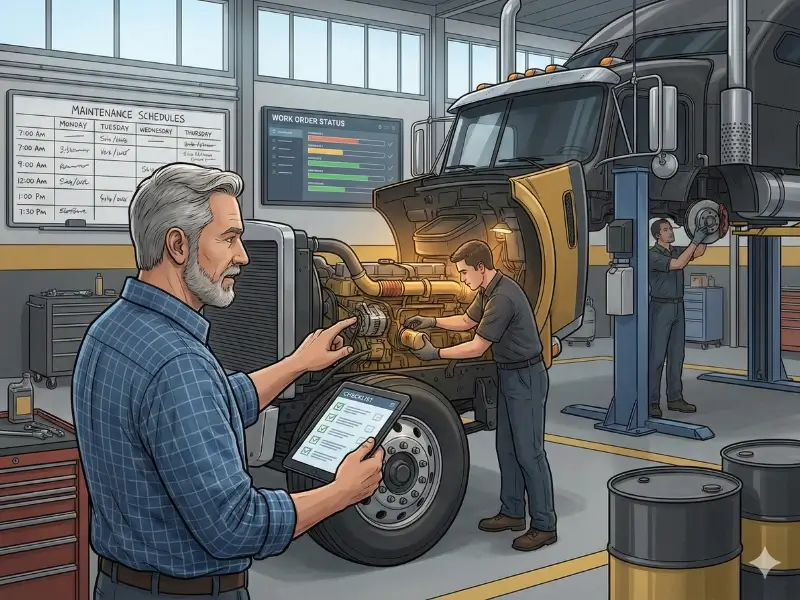Key Takeaways
In today's fast-paced business environment, staying compliant with fleet compliance regulations is a top priority for companies operating a fleet of vehicles. To effectively manage and streamline compliance processes, fleet compliance software has become a crucial tool for fleet managers. Understanding the importance of fleet compliance, key regulations, features of fleet compliance software, implementation steps, and best practices for maximizing its benefits are essential for staying ahead of regulatory requirements and maintaining an efficient fleet.
Understanding Fleet Compliance
Fleet compliance refers to adhering to a set of regulations and standards governing the operation and safety of commercial vehicles. The primary objective of fleet compliance is to ensure the safety of drivers, pedestrians, and other road users, while also minimizing environmental impact and maintaining control over operational costs. By implementing fleet compliance software, companies can effectively monitor, track, and manage their compliance activities to ensure operational efficiency and avoid costly penalties.
The Importance of Fleet Compliance
Complying with fleet regulations is not only a legal obligation but also a crucial aspect of maintaining a reputable and trustworthy image for your organization. Non-compliance can lead to severe consequences, such as fines, legal issues, damaged brand reputation, and even accidents. By staying compliant with fleet compliance regulations, companies can create a safe working environment, reduce the risk of accidents, and demonstrate their commitment to responsible business practices.
Key Regulations in Fleet Compliance
There are several key regulations that fleet managers need to be familiar with to ensure compliance. These include the Hours of Service (HOS) regulations, driver qualification requirements, vehicle maintenance standards, fuel efficiency standards, and electronic logging device (ELD) mandate, among others. Each regulation has its specific requirements and deadlines, making it crucial for fleet managers to stay updated and implement the necessary systems and processes to meet these regulations.
Let's delve deeper into some of these key regulations. The on-time trucking hours of service (HOS) regulations, for example, dictate the maximum number of hours a driver can be on duty and the mandatory rest periods they must take. These regulations aim to prevent driver fatigue and ensure that drivers are well-rested and alert while operating commercial vehicles.
In addition to driver-related regulations, fleet compliance also encompasses vehicle maintenance standards. Regular inspections, maintenance, and repairs are essential to ensure that commercial vehicles are in optimal condition and meet safety requirements. By adhering to these standards, companies can minimize the risk of mechanical failures and accidents caused by faulty equipment.
Another important aspect of fleet compliance is the electronic logging device (ELD) mandate. This regulation requires commercial drivers to use electronic devices to record their hours of service, replacing traditional paper logbooks. ELDs provide accurate and tamper-proof records of a driver's driving time, making it easier for fleet managers to monitor compliance with HOS regulations and ensure that drivers are not exceeding their maximum allowable hours.
Furthermore, fuel efficiency standards play a significant role in fleet compliance. These standards aim to reduce greenhouse gas emissions and promote sustainability in the transportation industry. Fleet managers must implement measures to monitor and improve fuel efficiency, such as using fuel-efficient vehicles, optimizing routes, and providing driver training on eco-friendly driving techniques.
As you can see, fleet compliance encompasses a wide range of regulations and standards that require careful attention and implementation. By staying informed and proactive in meeting these requirements, companies can not only ensure legal compliance but also enhance safety, reputation, and operational efficiency within their fleet.
An Overview of Fleet Compliance Software
Fleet compliance software is a comprehensive solution that helps fleet managers streamline compliance processes and ensure adherence to regulations. It offers a range of features that enable effective management of compliance-related tasks, data tracking, reporting, and analysis. By automating many manual tasks and centralizing compliance-related information, fleet compliance software improves operational efficiency, reduces errors, and provides real-time visibility into compliance status.
Features of Fleet Compliance Software
Fleet compliance software typically includes features such as driver management, vehicle maintenance tracking, electronic driver logs, safety inspections, fuel tracking, and reporting capabilities. These features allow fleet managers to monitor driver compliance with Hours of Service (HOS) regulations, track vehicle maintenance schedules, conduct safety inspections, monitor fuel consumption and emissions, and generate reports for regulatory audits or internal analysis. Additionally, some advanced fleet compliance software solutions may also provide real-time GPS tracking and geofencing features to enhance fleet monitoring and driver safety.
Driver management is a crucial aspect of fleet compliance software. It allows fleet managers to maintain driver records, track driver certifications and licenses, and monitor driver performance. With this feature, fleet managers can ensure that drivers are qualified and compliant with regulations, reducing the risk of accidents and violations.
Vehicle maintenance tracking is another essential feature of fleet compliance software. It enables fleet managers to schedule and track routine maintenance tasks, such as oil changes, tire rotations, and inspections. By staying on top of vehicle maintenance, fleet managers can prevent breakdowns, extend the lifespan of their vehicles, and ensure compliance with regulations regarding vehicle safety and performance.
Selecting the Right Fleet Compliance Software
When selecting fleet compliance software, it is essential to consider your specific compliance needs, the scalability of the software, ease of use, integration capabilities with existing systems, and customer support offered. Look for software solutions that provide a user-friendly interface, customizable reporting options, automated alerts and notifications, and robust security measures to protect sensitive data. It is also recommended to seek demonstrations and trial periods to assess the software's compatibility with your fleet management processes and overall usability.
Scalability is an important factor to consider when choosing fleet compliance software. As your fleet grows, you need a software solution that can accommodate the increasing number of vehicles, drivers, and compliance requirements. Ensure that the software can handle your current fleet size and has the flexibility to scale as your business expands.
Integration capabilities are also crucial, especially if you already have existing systems in place. Look for software that can seamlessly integrate with your current fleet management tools, such as telematics systems or fuel management software. This integration will allow you to consolidate data and streamline processes, eliminating the need for manual data entry and reducing the risk of errors.
Implementing Fleet Compliance Software
Implementing fleet compliance software requires careful planning and execution to ensure a smooth transition and maximum utilization of its capabilities. Following a well-defined implementation process can help overcome challenges and ensure successful incorporation into daily operations.
When implementing fleet compliance software, it is essential to evaluate your current compliance processes and identify areas of improvement and automation. This evaluation will provide valuable insights into the specific needs and requirements of your organization. By understanding these areas of improvement, you can effectively align the software's capabilities with your compliance goals.
Steps to Implement Fleet Compliance Software
- Evaluate your current compliance processes and identify areas of improvement and automation.
- Define goals and objectives for implementing the software, such as reducing administrative tasks, improving compliance accuracy, or enhancing reporting capabilities.
- Select a project team responsible for overseeing the implementation process and communicating with software vendors.
- Configure the software according to your organization's specific compliance requirements, including driver information, vehicle details, compliance rules, and reporting parameters.
- Train your team on how to effectively use the software and ensure they understand the new compliance processes and workflows.
- Gradually rollout the software across your fleet, starting with a pilot group and then expanding to other teams or locations.
- Monitor and review the implementation progress, making adjustments and providing additional training as needed.
One of the key challenges in software implementation is resistance to change. Employees may be accustomed to existing processes and may be hesitant to embrace new technology. To overcome this challenge, effective communication is crucial. Clearly communicate the benefits of the software and how it will streamline their daily tasks, reduce errors, and improve overall compliance. By involving employees in the implementation process, addressing their concerns, and providing comprehensive training, you can foster a positive attitude towards the new software and encourage widespread adoption.
Overcoming Challenges in Software Implementation
Implementing any new software may present challenges, such as resistance to change and the learning curve associated with adopting new processes. Effective communication, comprehensive training, and ongoing support are key to overcoming these challenges. Engaging employees in the implementation process, addressing their concerns, and highlighting the benefits of the software can help ensure a successful roll-out and encourage widespread adoption.
Furthermore, providing ongoing support and assistance is crucial in helping employees navigate the learning curve associated with the new software. This support can come in the form of dedicated help desks, online resources, or training sessions. By offering continuous support, you can empower your team to fully utilize the software's capabilities and maximize its potential benefits.
Download Our Fleet Inspection Software For Free
Maximizing the Benefits of Fleet Compliance Software
Once the fleet compliance software is implemented, there are several best practices to follow to maximize its benefits and ensure ongoing compliance.
Best Practices for Using Fleet Compliance Software
Regularly review and update compliance policies to reflect changes in regulations and business requirements. Conduct periodic internal audits to ensure that drivers and vehicles are adhering to compliance standards. Utilize the reporting capabilities of the software to track key metrics, identify areas for improvement, and generate accurate compliance reports for audits or inspections. Foster a culture of accountability and safety by providing ongoing training and incentives for compliance.
Maintaining Compliance with Fleet Compliance Software
Consistent monitoring and proactive management of compliance are essential for maintaining compliance with fleet regulations. Use the software's automated alerts and notifications to stay informed of upcoming compliance deadlines, expiring licenses, or pending maintenance tasks. Regularly review compliance reports and take corrective actions promptly to address any non-compliance issues. Maintain open communication with drivers, providing them with the necessary resources and support to meet compliance requirements.
Future Trends in Fleet Compliance and Software Solutions
Fleet compliance and software solutions are continually evolving to keep up with technological advancements and changing regulations.
Technological Advances in Fleet Compliance Software
Advancements in telematics, IoT (Internet of Things), and artificial intelligence are shaping the future of fleet compliance software. Integration with telematics devices allows real-time monitoring of driver behavior, vehicle performance, and fuel consumption, further enhancing compliance management. IoT-enabled sensors can provide accurate data on vehicle conditions, enabling proactive maintenance and reducing the risk of breakdowns. AI-powered analytics can process vast amounts of data to identify patterns, predict potential compliance issues, and provide actionable insights.
The Role of Fleet Compliance Software in Sustainable Fleet Management
Sustainable fleet management is becoming an increasingly important aspect of fleet compliance. Fleet compliance software can play a vital role in tracking and managing sustainability initiatives, such as managing fuel consumption, optimizing routes, and monitoring emissions. By integrating sustainability practices into compliance processes, fleet managers can contribute to environmental conservation efforts while also improving operational efficiency and reducing costs.
In conclusion, staying compliant with fleet regulations is crucial for ensuring safety, maintaining brand reputation, and avoiding legal issues. Fleet compliance software provides a comprehensive solution for managing compliance tasks, tracking data, and generating reports. By understanding the importance of fleet compliance, selecting the right software, implementing it effectively, and following best practices, fleet managers can maximize the benefits of fleet compliance software and stay ahead of regulatory requirements. With future trends in technology and sustainability, fleet compliance software continues to evolve, helping companies achieve operational excellence and environmental responsibility.
Take Control of Your Fleet Compliance with Simply Fleet
Ready to enhance your fleet's operational efficiency and ensure regulatory compliance? Simply Fleet offers a comprehensive suite of tools designed to streamline your fleet maintenance tasks. From preventive maintenance reminders and digital vehicle inspections to repair work orders and detailed logs of fuel, expenses, and service history, our platform empowers you to make informed decisions with consolidated data analytics. Don't let compliance complexities slow you down. Get Started with Simply Fleet today and drive your fleet towards maximum uptime and cost savings.



.png)








.png)


.png)





.webp)



